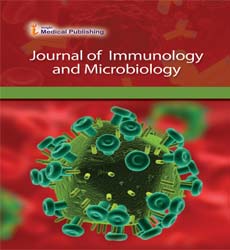Role of Microorganisms in Food Industry
Alfred Joy*
Department of General Microbiology, University of Texas, USA
- *Corresponding Author:
- Alfred Joy Department of General Microbiology, University of Texas, USA, Email: Alfred.joy@yahoo.com
Received Date: October 18, 2021; Accepted Date: November 01, 2021; Published Date: November 08, 2021
Citation: Alfred J (2022) Role of Microorganisms in Food Industry. J Immunol Microbiol. 5:1.
Commentary
Microbial science is essential to food safety, production, processing, preservation, and storage. Microorganisms like bacteria, fungi (molds and yeasts) are utilized in the production of foods like the synthesis of wine, brewery, bread, and dairy items. The growth and development of waste and pathogenic microorganisms are considered as one of the fundamental sources to the affect the shelf life of foods these days. Even though innovation, hygienic strategies, and detectability are significant factors to delay and prevent microbial development and contamination, food remains susceptible to the deterioration and action of pathogenic microorganisms. Food loss by one or the other deterioration or contaminated food influences the food industry and buyers prompting monetary loss and expanded hospitalization costs. This part centers around broad perspectives, attributes, and significance of principle microorganisms (bacteria, yeasts, molds, viruses, and parasites) engaged with food waste or contamination: known and as of recently discovered species; defects and modifications in staple; most normal food-related with each foodborne sickness; protection from warm handling; event in various nations; episodes; and related side effects.
Food microbial science concentrates on the job of microorganisms in food sources. It remembers parts of the microbial environment for food as well as the utilization of microorganisms for the production of ingredients and food varieties. In addition, a few microorganisms address a significant test for general wellbeing because of their capacity to cause infections. Food conservation targets inactivating and controlling the development of waste and pathogenic microorganisms, safeguarding rack steady and good food varieties. Subsequently, ceaseless efforts between food ventures, legislatures, and society have been made to further develop measurable examining instruments and microbiological techniques to comprehend the systems that influence the destiny of microorganisms in food varieties. Food preservation, from several ancient years, assumed a crucial part in the endurance of humankind improving the wellbeing and steadiness of various staples. Conventional strategies used to prevent food spoiling in the past as salting, drying, fermentation, and heating prevail in the current food industry. The information about the primary cause for decay has expanded considerably from that point forward and misfortunes because of deterioration and food pollution would be reduced.
The information about the composition, origin, pH, water activity of food and storage conditions (e.g., temperature, atmosphere, and pressure) alongside the data about the attributes of most common and safe microorganisms predicts the arrangement of microflora during handling and capacity. From this situation, the satisfactory utilization of innovation (like pasteurization and sterilization), sterile procedures (e.g., good hygiene practices and good manufacture practices), and traceability (prevent and controls the dissemination of dangerous and low-quality food) can forestall and defer the colonization of deterioration and pathogenic microorganisms in the food item. Be that as it may, foods will be susceptible to contamination and spoilage from pathogenic microorganisms all through the natural order of things, retail shops, eateries, and places of consumers.
The harm from deterioration and contamination of food influences the food business (monetary loss, harm to notoriety) and buyers. The waste of food by microbial action includes numerous and complex mechanisms wherein the acknowledgment of tactile properties rot and buyers reject the food. The presence of noticeable development as sludge and provinces changes in the surface because of corruption of proteins/carbohydrates/ lipids, and the impression of off-odors and off-flavors might demonstrate deterioration by microorganisms (e.g., bacteria and molds). Then again, the development, the cross-contamination, and toxin production of pathogenic microorganisms impair the safety of food and impose a risk to health of consumers. The ingestion and colonization of microorganisms in the human gastrointestinal system normally cause gastroenteritis, which is a condition described by diarrhea, digestive issues, feelings of queasiness, vomiting, and fever. The assessment of foodborne sicknesses on the planet is mind-boggling however global, public, and neighborhood efforts have been made to appraise the impact of foodborne infections around the world. The fundamental specialists engaged with gastroenteritis are microbes, even though parasites, viruses, yeasts, and molds are under-perceived reasons for gastroenteritis and they have been turning out to be more successive in the last ten years.
Acknowledgment
The authors are grateful to the journal editor and the anonymous reviewers for their helpful comments and suggestions.
Declaration of Conflicting Interests
The authors declared no potential conflicts of interest for the research, authorship, and/or publication of this article.
Open Access Journals
- Aquaculture & Veterinary Science
- Chemistry & Chemical Sciences
- Clinical Sciences
- Engineering
- General Science
- Genetics & Molecular Biology
- Health Care & Nursing
- Immunology & Microbiology
- Materials Science
- Mathematics & Physics
- Medical Sciences
- Neurology & Psychiatry
- Oncology & Cancer Science
- Pharmaceutical Sciences
